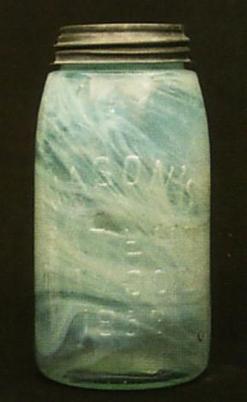Canning Jars
Canning jars, also called fruit jars, because early versions were primarily used for fruit, or Mason jars, after the best-known manufacturer, are one of those technological advances that have become so ubiquitous we've forgotten just how revolutionary the development of food preservation really was. Many of the greatest empires, events and discoveries of the 19th century were largely aided by the development of the canning process. Supplying armies, expeditions and explorations was always a challenge, because even if the efforts were not limited by the amount of food they could carry with them, they were certainly limited by how long most of it would remain edible. The most common methods historically were salting, sugaring, or drying, and they all presented drawbacks for primarily two reasons - limited kinds of foods were suitable for these methods, and the success of the preservation relied heavily on preventing bacteria-friendly moisture, a challenge in even the best conditions. Sustaining a large army on the move was so important that Napoleon once said that "an army marches on its stomach," and the French government offered a 12,000 franc prize in 1795 (about $17,000 in today's Euros) for a food preservation method to serve the military's needs. The winner, Chef Nicholas Appert, was a confectioner who spent 14 years experimenting with various methods before winning the prize by offering a way to heat food in glass jars that were corked and reinforced with everything from wire, wax and/or pitch. Appert could explain his process, but not his success; it would be decades before another French citizen, Louis Pasteur, would link the growth of microbes to the spoiling of food.Early methods of sealing were often so effective that they destroyed the jar's rim, so the process remained expensive by constantly demanding a supply of new jars. Even with other sealing methods, glass production remained expensive, so while there were a few exceptions, most commercial canning operations quickly moved to canning in tin containers. (These methods presented their own problems, chiefly through a contribution to lead poisoning due to lead-soldered seams in the tins. Some historians have attributed the fate of the 1845 Franklin Expedition to this danger.) During this same era, potters produced stoneware canning jars known as wax sealers, because they were sealed with a layer of melted wax poured over the top; this was the method of most individual efforts at food preservation.

A John Bell stoneware wax sealer with the original lid. The lid was put in place and then melted wax was poured over it, filling the reservoir to the top of the rim. (p4A item # D9871694)
In the 1850s, John Mason, a tinsmith, devised a process to cut threads into tin lids and paired these lids with jars with threaded rim. He patented his process November 30, 1858, a date found on legions of Mason jars. (Jars with this date are not early; the earliest Mason jars were plain and the use of the date in the jar design was implemented in the 1880s and used into the early 1900s.) Despite these advances, canned food was slow to catch on and was seen as novelty item for society's most affluent members. Even with an easier means of sealing, canning would not see a boom in popularity until a few decades later, when scientific discoveries would allow for the development of clearer, better quality glass and industrialization would make glass production cheaper and easier. As this happened, canning became more affordable and literally more attractive, as the clearer, lighter glass allowed women to monitor and enjoy the appearance of the finished product.
Of course, other companies quickly formed to follow suit - Consolidated in 1871, Ball in 1880, Lightning in 1882, Hazel-Atlas in 1902, Kerr in 1903 - and dozens of other small companies that manufactured jars like Hero and Ladies' Favorite. Today, canning jar collectors have thousands of jars to choose from, and while most jars may sell for just a few dollars, they can bring as much as $30,000. Value is driven by six factors: maker, marks, condition, color, form, and closure. Condition, of course, takes into consideration rim chips, cracks, flaws in the glass, etc., and certain colors are rarer and more desirable than other - jars came in a variety of colors, primarily shades of yellow to amber and pale blue to cobalt, so other colors that are less common can bring high prices. The remaining factors - maker, marks, form, closure - deal with the production boom in the late 1800s. Companies formed and failed, while outlandish methods of closure were experimented with at the time, often quickly proving impractical for food preservation. While not at all desirable in the period, the short production span of jars manufactured by certain companies or with certain methods of sealing has guaranteed them a rarity that equates to value on the modern market.

A milkglass Mason jar, valuable due in large part to the unusual color. (p4A item # A092359)
Further Recommended Reading
1000 Fruit Jars: Priced and Illustrated by Bill SchroederThe Collector's Guide to Old Fruit Jars by Douglas M Leybourne
Fruit Jars: A Collectors' Manual by Julian Harrison Toulouse